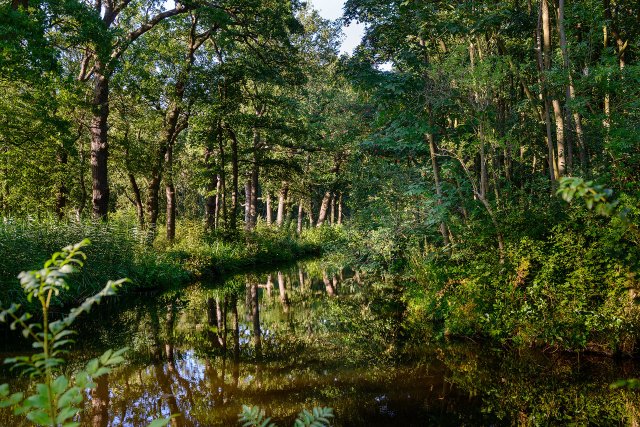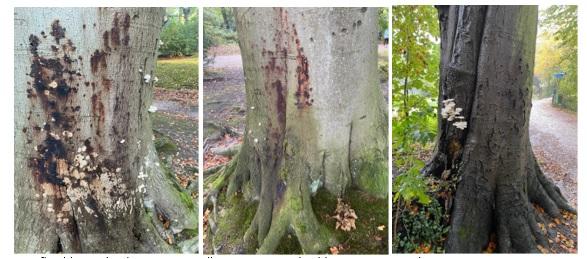Cutting and replanting of trees
Municipality of Wassenaar is a green municipality. Trees are important for Wassenaar. In our municipality there are more than a hundred monumental and valuable trees, divided between private and public properties. There are even 26,000 trees in the entire municipality. Trees increase the welfare, the well-being, and thus the living environment for all of us (people and animals). We want to keep them that way. And preserving the trees, we want to do that together with the residents.
That includes taking care when cutting down and replanting trees. Unfortunately, it is occasionally necessary to cut down trees. You can read below what our policy is on cutting down and replanting trees.

Reasons why we cut down trees:
- Illness;
- Storm damage;
- Insecurity;
- As part of recovery and management plans.
Tree felling in case of illness
We do a lot of prevention to prevent diseases in trees. Unfortunately, we cannot always prevent trees from getting sick. Also, sometimes a tree becomes diseased or bad because of damage to a trunk caused by vehicles, for example.
Most common diseases or infestations of trees are:
- Various types of fungi (in lime, beech, horse chestnut, among others);
- Ash dieback (in ash trees);
- Chestnut blight (in horse chestnut trees).
Example of infestation by fungi
Some trees are affected by Honey fungus, Porcelain fungus and/or Lichen charcoal fungus. Not only does this cause the trees to die, but Porcelein fungus and Shortwood charcoal fungus also cause an extremely high chance of branches breaking off. These fungi are, so to speak, wood breakers, making trees unstable. This is especially the case with trees such as Beech, Horse Chestnut and Lime. If a tree is affected by fungi, there is an increased risk of branches falling or even the tree falling over. Therefore, in this case, the tree must be removed.

Who decides which trees are diseased and should be cut down?
When it comes to safety and disease, this is usually determined by our senior manager Green who consults with the Green managers. In cooperation with outside party VTA (Visual Tree Assessment), the trees that line avenues and streets are inspected annually. Each year, 1/3 of the municipality is inspected for this purpose. A report is then issued each year on the inspected section. The senior manager Green then assesses whether a tree should be cut down according to strict guidelines.
Visual Tree Assessment avenue and street tree reports are not routinely posted on our websites. In some cases, acute situations are communicated.
Tree canopy in case of storm damage
High winds cause more branches to fall out than usual, even on healthy trees. If a tree has lost many branches after a hard storm, the municipality considers whether the tree should be pruned or cut down. In some cases, the tree will be cut down.
Tree felling at unsafe trees
By unsafe trees, we mean trees that are very crooked, diseased or bad and thus may pose a hazard to passersby. These trees stand along paths or hang crookedly over paths. By regularly inspecting trees, we keep a closer eye on these trees.
Oak Processionary Moth
Each year around the start of spring, the municipality considers whether it is necessary to control hostile (invasive) insects or animals. A consideration is made whether or not to control and in what way. This also depends on government advice. Oak processionary caterpillar removal from trees is done with a suction method. Trees are not affected and therefore not felled. The hairs of the oak processionary caterpillar can cause annoying symptoms. Read more about oak processionary caterpillars and how the municipality deals with them.
What happens to the wood from the felled trees?
The trees will be removed by an outside party with the proper equipment that the municipality of Wassenaar has a contract with. The price and the contract we discuss with the contractor include the wood. After the felling, the contractor may use this wood freely.
Part of recovery and management plans
The municipality develops, maintains trees and tree structures with the aim of preserving and enhancing the unique and green character of Wassenaar. The planting of avenues along (historic) roads is unique and creates a beautiful green image of Wassenaar. These trees tell the story of the development of our village. They are important for our health and well-being.
These trees are largely located on the grounds of country estates, estates and villa districts. During restoration or management projects of these estates and country estates it happens that a group of trees is cut down. We do this when this leads to quality improvement of an estate. The cultural-historical values, natural values and financial values play an important role in this. Our goal here is to preserve the old, monumental and healthy trees as much as possible.
During work such as tree felling, parts of an estate will be temporarily closed. The remaining parts will be open.
Replanting of trees
When the municipality cuts down trees, we almost always replant new trees. Whenever possible, we replant at the location of the removed tree. When that is not possible, replanting takes place at another location within the municipality.
Trees along streets and avenues we replant as much as possible in the existing structure of the avenue or street, so that the green image remains.
For the trees felled in 2022, 270 will be replanted this year. We are planting all kinds of trees: from oak, to linden to chestnuts and blueberries. Here we take into account that we replant as many area-specific trees as possible. This way we keep appropriate trees in streets and avenues and improve biodiversity. Read more about historic tree avenues.
Trees that fall under redevelopment projects or restoration of country estates are not included in this. For these trees, a replanting plan will be drawn up per project, in collaboration with the municipality and project leader. We place the numbers of felling and replanting in the permit applications, after which they are published on the website.
From the municipality, we only communicate about the replanting of trees during large-scale and planned felling operations.